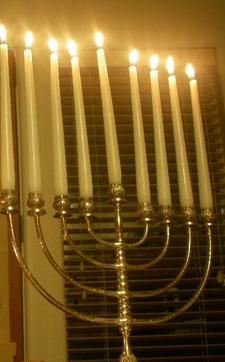
ב''ה
 Subscribe to our
Subscribe to our
If you’re a Gentile who’s observant of Torah’s Seven Noahide Commandments, you may be interested in lighting Hanukkah candles. If so, you can very easily buy or make a Hanukkah menorah lamp (see below). Your intention for doing this should not be to fulfill the Rabbinical commandment, which is only for Jews. Rather, it should achieve the practical objective of publicizing the One G-d’s open miracles.
We recognize G-d’s miracles in His physical and spiritual redemption of the Jews when the Greek empire was oppressing them. This happened in Judea in the second century B.C.E. Gentiles can publicize these miracles safely (!) by lighting the Hanukkah candles in a place like a window sill, where the candle flames can be seen at night by people who are walking or driving by. They can also publicize this by speaking about this message to their family and other people. The objective is to educate and remind them about the truth and greatness of the One G-d.
Rabbi Moshe Weiner (author of The Divine Code) verified that Noahides may light Hanukkah candles with that intention and purpose. They may do this in the same manner as the Jewish custom, but without reciting the associated Jewish blessings. (For Gentiles, saying those blessings would be false statements said in G-d’s Name, G-d forbid. The blessings testify that the person lighting the candles is commanded to kindle the lights of Hanukkah. The blessings also state that G-d did those miracles for “our fathers”. Both of those statements apply only to Jews.)
A Noahide may say any of the suggested readings and Psalms listed below, after lighting Hanukkah candles.
In 20’25, Hanukkah starts Sunday, December 14, at sundown. Hanukkah ends Monday, December 22, at sundown.
“We praise You, G-d, for the miracles, for the redemption, for the mighty deeds, for the saving acts, and for the wonders which You performed in those days, at this time: In the days of Matisyahu, the son of Yochanan the High Priest, the Hasmonean and his sons, the wicked Hellenic government rose up against the people of Israel to make them forget Your Torah and violate the decrees of Your will. But You, in Your abounding mercies, stood by them in the time of their distress.
You waged their battles, defended their rights, avenged the wrong done to them, delivered the mighty into the hands of the weak, and the many into the hands of the few, the impure into the hands of the pure, the wicked into the hands of the righteous, and the wanton sinners into the hands of those who occupy themselves with Your Torah. You made a great and holy name for Yourself in Your world, and effected a great deliverance and redemption for the people of Israel to this very day.
Then the Israelites entered the shrine of Your Holy House, purified and rededicated Your sanctuary, kindled lights in Your holy courtyards, and instituted these eight days of Hanukkah to give thanks and praise to Your great Name.”
It’s a good thing to give extra charity during Hanukkah to a proper charitable institution or cause, or to needy individuals. It’s good to have a charity box or can (a “pushka“) in your home, that you can drop coins into frequently and then give them to a proper charity when it is filled up.
Parents can give small gifts of money (Hanukkah “gelt”) to their children on some or all of the days. This is useful for teaching them to put part of their money (for example 10%) into a charity box at home, to be given later to a proper charity. (Note: We recommend not to give gifts specifically as “Hanukkah presents”. This recent development distorts the true message of Hanukkah. Rather, gifts can be given just as at any other time.)
It’s especially customary during Hanukkah to enjoying some Hanukkah recipes for oil-fried or dairy foods. The oil-fried foods are eaten to remember the miracles of the small jug of pure oil for the menorah in the Temple. The first miracle was that the jug was found after the Greek army retreated from Jerusalem. It had only enough oil to burn in the menorah for one day. Then miraculously, the oil burned for 8 days.
The dairy foods are eaten to remember the military victory of the Maccabee priests (Kohanim, descended from Aaron) over the Greeks. This is because Jerusalem was retaken by the Maccabee brothers through of the heroic act of Yehudit (or Yehudis), their righteous sister. (She came to the Greek general and fed him a feast of cheese and wine. When he fell asleep, she dealt to him the end he deserved, and the leaderless Greek army panicked and retreated.)
Four-part Audio Series on the historical events of Hanukkah
Lesson from Hanukkah to Publicize the 7 Laws of Noah
Expanded-edition video of the Rebbe’s talk on Thanksgiving and Hanukkah
A Miraculous Story for the Fifth Night of Hanukkah
Video lesson: The Kabbalistic Spin on the Hanukkah Dreidel